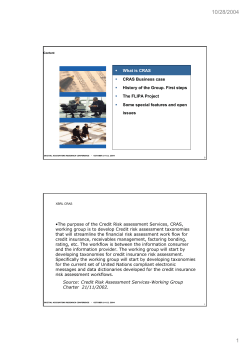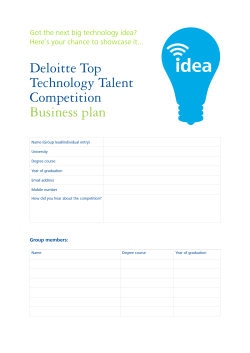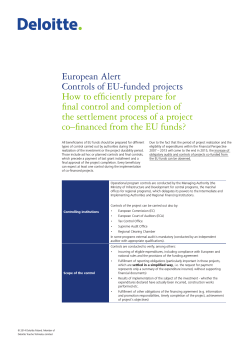
Practical Experiences of Introducing XBRL for taxation to the Jeff Smith
Practical Experiences of Introducing XBRL for taxation to the Business Community in the UK Jeff Smith Customer Champion Business Customer Unit, 6th May 2008 A brief history • HMRC first became aware of XBRL in 2001. – What attracted us: 1 vision of streamlining the end to end financial reporting process - linking business, accounting and tax software. 2 access to data - rather than everything on paper. 3 picking up an external initiative - origins within the financial community, not Government driven. 4 possible data standard in a wider government context. A brief history • March 2003 – e-filing service goes live (designed at the outset to become XBRL based): – XML based Company Tax return form + tax computations + accounts (as pdf’s). – Enabled proving of the basic service before adding XBRL. • February 2006 – XBRL capability added: – Allows computations to be submitted in XBRL format – Taxonomy for computational items created by HMRC. – Accounts as and when suitable taxonomies become available (UK GAAP & IFRS) and XBRL accounts are produced. External review of HMRC online services • July 2005 - UK Government asked Lord Carter to advise on measures to increase the use of HMRC’s key online services, in order to ensure sustainable and efficient service delivery for taxpayers, while continuing to support compliance. • March 2006 - UK Government accepts recommendations in full. Key recommendations (for XBRL): • “All companies should be required to file their company tax returns online, using XBRL …….. for returns due after 31 March 2010.” • “Our view is that HMRC should not require online submission of company tax returns until XBRL has been implemented and has bedded down.” • “We also recommend that they [HMRC & Companies House] should work towards providing a joint filing facility so that companies and their agents only have to submit the same information once.” Ongoing work • Getting XBRL “bedded down” 1. Improving taxonomies – funding of further work on UK GAAP (including IFRS convergence). – Discussions with tax software developers and accountants about level of detail required in the tax computation is ongoing. 2. Rendering – a basic requirement – Stylesheet not practical for complex accounts or computations. – Getting the issue on the XBRL agenda. – Encouraging technical debate. – Deciding which solution(s) to support. 3. Developing “joint filing facility” with Companies House Ongoing work – building the business benefits case • Very important to HMRC that companies and accountants support the move to XBRL – discussions ongoing with professional bodies. – Not generally accepted that external business benefits can be realised yet – although XBRL is seen as a good idea in principle. – Why should software developers enhance products when customers aren’t asking for XBRL? – Need to demonstrate that XBRL is a good thing for business. – Remarkably few business cases have been published that demonstrate in costed terms how external (non-governmental) entities benefit from XBRL. – Finding examples; checking the facts. – Generalised phrases, such as “steamlining the financial reporting process”, aren’t enough. Ongoing work – building the business benefits case • Deloitte Australia have produced the most compelling business benefits case that I have seen so far, but please tell me if you know of other examples. • The following slides are extracted from a fuller presentation, which Deloitte Australia have kindly given me permission to use. • HMRC are talking to Deloitte about the applicability of this process in a UK context. XBRL enabling financial reporters SBR / XBRL International Conference – Brisbane November 2007 Why we’re excited! Moving on from Luca Pacioli • Ease of aggregation • Retire or rejuvenate legacy systems • Our people are engaged and enthusiastic • Better analysis of client information • Less time spent on ‘data drudgery’ The pilot system A new approach Map client trial balance Calculate & validate report data Import data & generate report Map client trial Validate balance to the instance, Import instance Deloitte compute document into Taxonomy to missing fact report template produce a first values and store run instance revised instance Publish report Review Add missing fact values such as Submit for Director details, Partner review select notes and and finalise for publish to client sign off Deloitte specification Lodge Lodge instance to regulator Lessons learnt Jumping hurdles Hurdle #1: Client accounting systems that can not produce XBRL instances – Re-key or – Convert Result: we built a conversion tool Hurdle #2: We need a financial report that is human (partner) friendly – Re-key into MS Word and/or MS Excel or – Automate Result: we built a publishing tool Hurdle #3: There is no published Australian Taxonomy – Sit and wait or – Get in and create one Result: we created our own taxonomy Financial reporting under “data drudgery” 16% Administration of client engagement including setting budget, engagement terms and risk review Financial reporting under “data drudgery” 63% To prepare a financial report ready for review by the partner 20% Review 1% Lodge Financial reporting under “XBRL” Map client trial balance Calculat e& validate report data Import data & generat e report Publish report Review Lodge -86% To prepare a financial report ready for review by the partner This reduction in processing time alone represents a saving of 54% in total time More information? Peter Williams CEO Deloitte Digital pewilliams@deloitte.com.au +61 3 9208 7629 Bevan McLeod Account Director Deloitte Growth Solutions bmcleod@deloitte.com.au +61 3 9208 7767 Ongoing work • Standardised Business Reporting 1. HMRC supports the concept but too early to predict what (if anything) may happen in the UK. – Some very high-level analysis of the potential scope has been done. – Work with Companies House on joint filing is a step in the right direct – ensuring that we adopt consistent standards and approach – sticking to XBRL standards and no proprietary solutions! 2. In close contact with Netherlands and Australian project teams. Questions?
© Copyright 2025




















